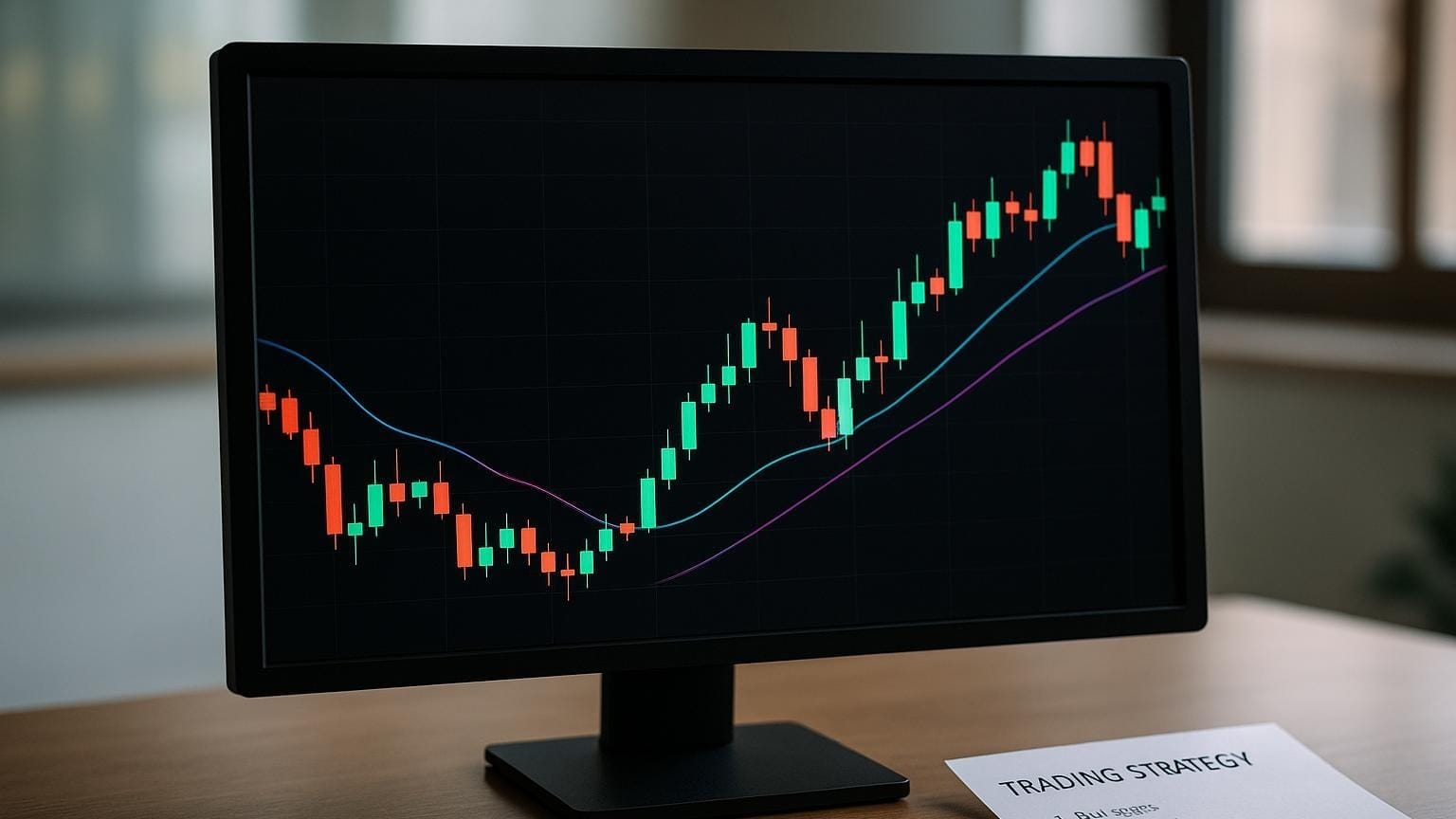Learn how to choose the right algorithmic trading platform by exploring essential features, beginner-friendly options, and key strategies for success.
Algorithmic trading automates trades using pre-programmed rules, analyzing markets faster than humans. It helps reduce emotional decisions, lowers manual errors, and can operate 24/7. If you're new to algo trading, here’s how to choose your first platform:
Key Features to Look For
- Ease of Use: Platforms like TrendSpider offer visual tools and tutorials, making them beginner-friendly.
- Testing Tools: Backtesting and analytics (e.g., QuantConnect) help refine strategies.
- Broker Connections: Ensure smooth execution with low latency and compatible APIs.
Beginner-Friendly Platforms
| Platform | Monthly Cost | Best For | Features for Beginners |
|---|---|---|---|
| LuxAlgo | Free plan; Premium $39.99; Ultimate $59.99 | Versatile Trading | Library of indicators, exclusive toolkits, AI Backtesting, community support |
| Coinrule | $29.99 | Crypto Trading | Pre-built templates, free tier |
| TrendSpider | $29.00 | Stock Analysis | Automated pattern recognition |
| Botsfolio | 0.5% yearly | No-Code Setup | Instant setup, no coding needed |
First Steps
- Choose a Platform: Match it to your skill level and goals.
- Set Up Your Account: Configure data feeds and broker APIs.
- Test Strategies: Start with simple strategies (e.g., Golden Cross) and backtest thoroughly.
Tips for Success
- Use demo accounts to practice risk-free.
- Focus on data quality and risk management.
- Keep strategies simple and test extensively before live trading.
Whether you're trading stocks or crypto, start small, learn the basics, and refine your approach with the right tools.
Algo Trading — Selecting a Broker and Trading Platform
Key Platform Features
If you're diving into algorithmic trading, you'll want to focus on a few essential platform features to get started on the right foot.
Easy-to-Use Interface
TrendSpider, with its highly-rated point-and-click interface (4.8/5.0), makes it easier to learn and achieve better trading results.
Top platforms typically offer:
| Feature | Benefit |
|---|---|
| Visual Strategy Builder | Design trading algorithms without coding |
| Educational Resources | Access tutorials and detailed guides |
| Demo Account Access | Test strategies without financial risk |
| Real-time Market Data | Stay updated with live market insights |
| Custom Indicators | Tailor strategies to your preferences |
Testing Tools
Backtesting tools are crucial for refining your strategies. QuantConnect is a standout example, with an active community creating new algorithms every month.
"When choosing algo trading software, I consider factors like ease of use, customization options, and support quality. It's crucial to pick a platform that aligns with your trading goals and technical skills." – Barry D. Moore, Certified Financial Technician
Effective testing tools should provide:
- Access to historical data for comprehensive strategy validation
- Detailed analytics to measure performance
- Risk management options to evaluate potential losses
- Tools for fine-tuning strategies (and the ability to include fees, slippage, and realistic order fills)
Broker Connections
Broker integration plays a big role in how smoothly your trades execute. Different platforms offer varying levels of connectivity and pricing:
| Platform | Monthly Cost | Key Features |
|---|---|---|
| Trade Ideas | $228 | Pre-built algorithms, real-time signals |
| TrendSpider | $54 | AI-powered tools, automated analysis |
| Tickeron | $125 | Pre-designed algorithms, smart tech |
When assessing broker connections, focus on:
- Execution Speed: Low latency is critical for success in algo trading.
- Market Access: Check compatibility with your preferred trading venues.
- Cost Structure: Compare transaction fees and subscription prices.
- API Reliability: Ensure stable connections with minimal downtime.
For beginners, platforms like TradingView provide broad global market coverage, while Trade Ideas and TrendSpider are better suited for U.S. markets. Pick a platform that aligns with your trading goals and target markets to set yourself up for success.
Popular Platforms for Beginners
If you're just starting out with algorithmic trading, it's essential to choose a platform that caters to beginners. Here's a closer look at one beginner-friendly option and a comparison of other popular platforms.
LuxAlgo: Indicators and Exclusive Tools Overview
LuxAlgo provides hundreds of free trading indicators along with exclusive tools and an AI Backtesting platform, making it a strong choice for newcomers on TradingView. Key features include:
| Feature Category | Capabilities |
|---|---|
| Free Library | Access to hundreds of indicators compatible with TradingView; learn more in the PAC docs, S&O docs, and OSC docs. |
| AI Backtesting | Try AI Backtesting and read the AI Backtesting Assistant guide to build and iterate strategies in minutes. |
| Exclusive Toolkits | Signals & Overlays™, Price Action Concepts™, and Oscillator Matrix™. |
| Screeners | Explore Screeners on the site or add them directly from the Library: S&O Screener and OSC Screener. |
| Backtesters | Get a head start with Backtesters or dive into the Backtester (S&O) docs. |
LuxAlgo offers pricing plans to suit different experience levels:
- Free Plan: $0, lifetime access. Includes hundreds of tools across 5+ platforms.
- Premium: $39.99/month – advanced signals, alerts, oscillator tools on TradingView.
- Ultimate: $59.99/month – includes AI Backtesting platform.
See details on the LuxAlgo pricing page.
"LuxAlgo has really stepped my trading up; there is a setup for any style of trading you prefer. You don't have to put yourself in a box." – Kevin Ortega
Platform Features Comparison
Here's a comparison of beginner-friendly platforms to help you decide:
| Platform | Monthly Cost | Best For | Features for Beginners |
|---|---|---|---|
| Coinrule | $29.99 | Crypto Trading | Free starter plan with pre-built templates |
| TrendSpider | $29.00 | Stock Analysis | Automated pattern recognition |
| Botsfolio | 0.5% yearly | Quick Start | No coding required with instant setup |
| TradeStation | Variable | Comprehensive Trading | EasyLanguage programming and educational resources |
TradeStation makes it easy for beginners to dive in with its EasyLanguage programming, while NinjaTrader can require more technical expertise due to its C#-based system.
For crypto enthusiasts, Coinrule's free tier allows you to test strategies with up to $3,000 in monthly trading volume. Meanwhile, Zen Trading Strategies stands out for its clear tutorials and structured learning approach.
Tips for Choosing a Platform:
- Opt for platforms with demo accounts to practice risk-free.
- Match tools to your technical abilities.
- Prioritize reliable customer support.
- Look for platforms with integrated educational materials.
- Ensure compatibility with your preferred markets and brokers.
Next, you'll learn how to set up your account and start building your strategy step-by-step.
Setup Guide
Account Setup Steps
Follow these steps to configure your account:
-
Platform Selection & Registration
Pick a platform that aligns with your expertise. During registration, you'll typically provide:- A valid email address
- Details about your trading experience
- Your preferred markets (e.g., stocks, cryptocurrency, forex)
- Payment details (e.g., LuxAlgo Premium at $39.99/month or Ultimate at $59.99/month; a Free Plan is also available)
-
Data Feed Configuration
Set up real-time and historical data feeds to ensure thorough testing:- Link your broker's API to the platform
- Double-check the data for accuracy and consistency
-
Development Environment
- For coding platforms:
Install Python 3.8 or later, along with the librariespandasandnumpy. Set up API keys and authentication. - For no-code platforms:
Log in via the platform's web interface, connect to supported charting tools (e.g., TradingView), and ensure indicators are compatible.
- For coding platforms:
Once you've completed these steps, you're ready to create your first trading strategy.
First Strategy Setup
Start with a straightforward and popular strategy, such as the Golden Cross strategy.
Key Parameters:
- Short-term moving average: 50-day
- Long-term moving average: 200-day
- Asset class: US equities
- Trading frequency: Daily
| Component | Settings |
|---|---|
| Entry Signal | Short MA crosses above Long MA |
| Exit Signal | Short MA crosses below Long MA |
| Position Size | 1–2% of portfolio per trade |
| Stop Loss | 2% below entry price |
| Take Profit | 6% above entry price |
Strategy Testing Guide
Test your strategy through these steps:
-
Initial Backtesting
- Use at least 12 months of historical data.
- Test across different market conditions, including bullish and bearish trends.
- Monitor metrics like win rate, profit factor, and maximum drawdown.
-
Optimization Process
- Adjust moving average periods and refine entry/exit rules.
- Experiment with different position sizing methods.
-
Paper Trading
- Simulate your strategy in real-time for an extended period (e.g., 30 days).
- Compare the simulated results with your expectations.
- Note any discrepancies and make improvements.
Key Metrics to Track:
- Win Rate: Aim for above 50%.
- Risk-Reward Ratio: Target around 1:3.
- Maximum Drawdown: Keep it below 15%.
- Sharpe Ratio: Look for a minimum of 1.5.
Use these metrics to fine-tune your strategy before moving to live trading. If you want to accelerate this process, try LuxAlgo's AI Backtesting, then evaluate signals with Signals & Overlays or trends with Oscillator Matrix.
Tips and Common Errors
Key Tips
Boost your algorithmic trading performance with these practical guidelines:
-
Data Quality Management
Use dependable, high-quality data feeds, ensure data remains consistent, and organize datasets to make debugging easier. -
Risk Management
Set clear stop-loss levels and position-sizing rules to protect your capital; you can also set alerts and confirmations using Signals & Overlays™ and study trends with Oscillator Matrix docs.
What to Avoid
Steer clear of these common mistakes to avoid unnecessary setbacks:
-
Strategy Development
Keep your algorithms simple, thoroughly test them before going live, and resist the urge to make frequent changes. Consider automating core price action concepts (S/R, trendlines, patterns) via Price Action Concepts™ to keep charts clean and consistent. -
Technical Setup
Ensure your setup is solid: rely on reliable hardware, maintain a stable internet connection, and keep your systems updated.
Learning Materials
Expanding your knowledge is essential for growth in algorithmic trading. Here are some resources to consider:
-
Community Resources
Join trading communities like TradingView chat rooms, and participate in webinars or live sessions hosted by established platforms. -
Educational Platforms
Explore interactive tutorials on QuantConnect, take courses like Udemy's Python for Financial Markets, or dive into guides provided by platforms such as LuxAlgo documentation.
Next Steps
Kick off your algo trading journey with these practical steps.
Start by building a solid understanding of financial markets. Focus on key concepts like market orders, limit orders, and risk management. For beginners, the NSE Academy's Algorithmic Trading Module ($92.50) provides a structured curriculum to get started.
Platform Selection and Setup
Choose a platform that matches your skill level and risk tolerance. Spend time learning its features, especially those that align with your trading goals.
Strategy Development Path
Create a straightforward strategy using a few indicators. Backtest it with historical data and practice through simulated trading before committing real money. Once you’ve fine-tuned your approach, implement strong risk controls to safeguard your investments.
Risk Management Framework
Set clear rules for stop-losses and position sizing. When you’re ready to explore automated detection of market structure and liquidity concepts, review the Price Action Concepts docs and the PAC Library page.
"The field of algo trading is rapidly evolving every day and it has become necessary to master it to remain competitive in the Indian stock market ecosystem." – marketfeed Team
Continuous Learning Resources
Expand your knowledge with these resources:
- Join the r/algotrading community on Reddit for peer support and feedback
- Engage in forums like Elite Trader to learn from seasoned traders
- Take courses like Udemy's Python for Financial Markets to sharpen your technical skills
References
- LuxAlgo — Official Site
- LuxAlgo — AI Backtesting Assistant
- Docs — AI Backtesting Assistant
- LuxAlgo — Pricing
- LuxAlgo — Screeners (Overview)
- LuxAlgo — Backtesters (Overview)
- Signals & Overlays™ (Library)
- Price Action Concepts™ (Library)
- Oscillator Matrix™ (Library)
- S&O Screener (Library)
- OSC Screener (Library)
- Docs — Price Action Concepts Toolkit
- Docs — Signals & Overlays Toolkit
- Docs — Oscillator Matrix Toolkit
- Docs — Backtester (S&O)
- TrendSpider
- QuantConnect
- TradingView
- Coinrule
- Botsfolio
- Trade Ideas
- Tickeron
- TradeStation
- Zen Trading Strategies
- NSE Academy








